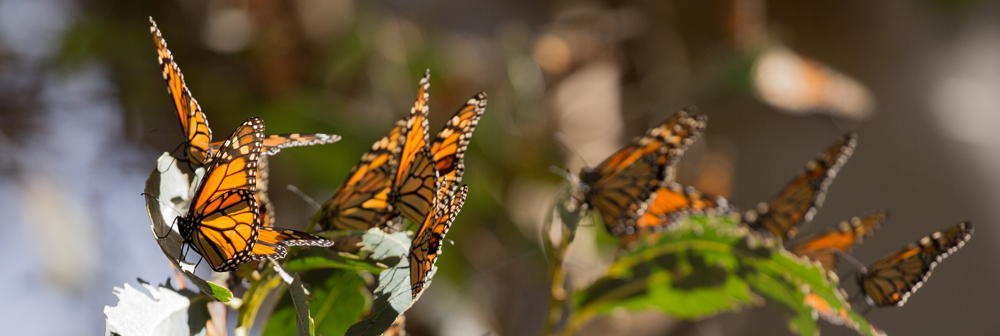Restoring Monarch Butterfly Habitat
One of North America’s Most Iconic Creatures
The life cycle and journey of the monarch butterfly is nothing short of amazing. Across multiple generations, monarchs make a 6,000-mile journey from Mexico in the spring, to the U.S. and Canada in the summer and back to Mexico in the fall.
Unfortunately, the number of monarchs making the trip to Mexico has declined over the past two decades. Many factors, including the loss of milkweed in the United States, habitat loss in the Mexican forests, climate change and weather events all contribute to annual variations. Fortunately, monarchs are a resilient species. Those of us in agriculture can play an important role in the effort to bring the monarch population back.
Farmers and ranchers are traditional stewards of the land across much of the historical monarch habitat, putting them in a unique position to increase monarch habitat in concert with productive agriculture and livestock operations. Evolution of modern agricultural practices driven by breeding and crop protection advances and guided by data science satellite technologies are helping to reduce environmental impacts, increase crop productivity, and enable monarch conservation efforts.


Collaborating with Others
We’re working with biodiversity experts from universities, farmers, conservation groups and government agencies across North America to restore the habitat and ecosystem for the monarch butterfly and other pollinators.
University of Guelph Canada
The grant will help to understand migration patterns and identify priority areas for milkweed restoration in the United States and Canada so that investments in habitat improvement are more successful.
Monarch Watch
A nonprofit education, conservation, and research program based at the University of Kansas, this program focuses on the monarch butterfly, its habitat, and its spectacular fall migration. This grant will enable Monarch Watch to produce and make available milkweed plants free of charge for landscape improvement, including buffer strips on farmlands, roadsides, rights of way, parks, public lands and demonstration plots along the monarch’s migratory path, which stretches from Mexico to Canada.
National Fish & Wildlife Foundation
Monsanto committed $3.6 million over three years to the National Fish and Wildlife Foundation’s Monarch Butterfly Conservation Fund to provide habitat restoration, education and outreach, and milkweed seed and plant production. Through this partnership with NFWF and five federal agencies, in 2015 and 2016 the fund supported 47 projects and leveraged $2.4 million from Monsanto with $5.7 million from other partners and over $12.2 million in grantee match for a total conservation impact of more than $20.3 million.
Keystone Policy Center Monarch Collaborative
Keystone Policy Center Monarch Collaborative consists of national organizations representing farmers, ranchers, and land owners; businesses working along the agricultural supply chain; researchers and academic institutions; federal and state entities; and conservation organizations. The Collaborative is utilizing the expertise and experience of its members to identify agricultural and conservation practices to support healthy monarch populations and promote the implementation of practices that will support monarch butterfly populations in agricultural landscapes.
The Iowa Monarch Conservation Consortium
The grant will help drive research to create quality habitat, develop guidance and demonstrations for farmers to cost-effectively improve and expand habitat, and monitor milkweed and adult monarch populations to track progress. The Iowa Monarch Conservation Consortium can serve as a model framework for other state-level initiatives planning to implement monarch conservation initiatives.
Pheasants Forever
The grant enabled the planting of monarch and pollinator habitats at more than 70 Monsanto research and manufacturing sites and facilities located in the monarch breeding range. This includes the creation of three Learning Center programs to demonstrate how to establish sustainable monarch and pollinator habitat, which is also the same habitat critical to upland birds. These programs engage, enroll and educate farmers and communities to contribute to a resilient monarch population.
Missourians for Monarchs Collaborative
The mission of the Missourians for Monarchs collaborative is to engage Missourians to increase and sustain habitat for monarch butterflies and pollinators through citizen involvement, and to seek ways for partners, communities and agencies to coordinate similar efforts. Its members consist of citizens, conservations and agriculture organizations, government agencies, utilities, agribusiness and non-profit organizations.
Sand County Foundation
Sand County is a non-profit private land conservation organization whose mission is to inspire and enable private landowners to ethically manage the natural resources in their care.


Our Efforts to Restore the Monarch
Research on habitat expansion and monitoring.
Plant milkweed along the monarch migration path.
Work with farmers and communities to increase the diversity of landscapes and provide more habitat for monarch butterflies.
Helping Monarchs Helps Maintain a Healthy, Diverse Ecosystem
The monarch butterfly plays a role in assisting with pollination of flowers and some crops. A healthy habitat is vital for biodiversity and biodiversity is important to sustainable farming.
Monarch habitat provides pollen and nectar that supports pollination of flowers and some crops. There are several botanical gardens and community gardens that provide information on adding milkweed to your garden. Learn more about Monsanto’s commitment to collaborate with others for the monarch butterfly.









